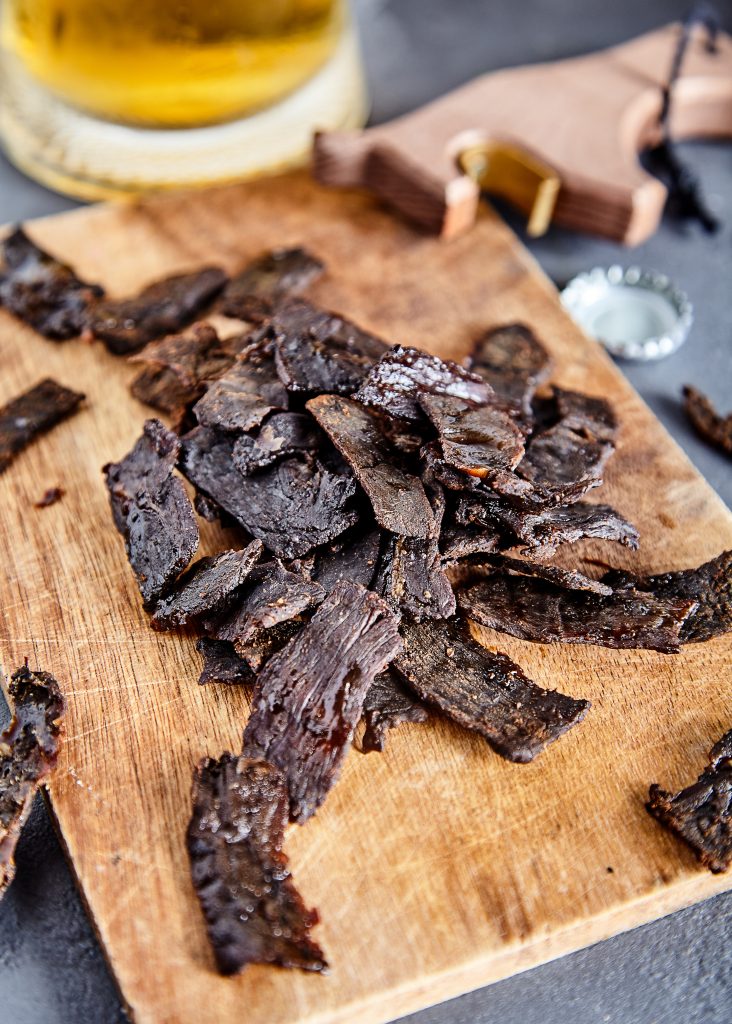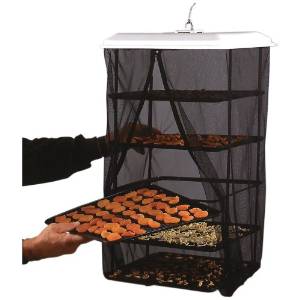Methods for drying meat to make jerky.
Before examining the methods to make jerky, let’s discuss why dehydrating meat is essential and valuable besides making a great-tasting snack.

Photo by Alex Bayev
Why Dehydrate Meat?
Dehydrating meat serves several practical purposes and offers numerous benefits, making it a popular method of food preservation and snack preparation.
Here are some of the key reasons why people dehydrate meat
- Longer Shelf Life: Dehydrating meat removes moisture, which is a critical factor in spoilage. With reduced moisture content, the meat becomes less susceptible to bacterial growth, mold, and decay, significantly extending its shelf life.
- Lightweight and Portable: Dehydrated meat is lightweight and compact, making it an ideal choice for hiking, camping, and other outdoor activities. It’s a convenient way to carry high-protein, energy-rich food without the weight and bulk of fresh meat.
- Convenient Storage: Dehydrated meat takes up less space than fresh meat, making it easier to store in your pantry or on your shelves. It doesn’t require refrigeration or freezing, saving valuable storage space.
- Nutrient Retention: Dehydrating meat preserves most of its essential nutrients, including protein, while reducing the risk of nutrient loss due to high heat. This means that you can enjoy a nutrient-rich snack or ingredient for your meals.
- Flavor Concentration: The removal of water during the dehydration process results in the concentration of flavors. This intensifies the taste of the meat, creating a rich, savory, and often more robust flavor.
- Reduced Waste: Dehydrating meat can help reduce food waste by extending the usability of cuts that might not be consumed immediately. It’s an excellent way to maximize surplus or less desirable meat cuts.
- Convenient Snack: Dehydrated meat, such as jerky, is a convenient, on-the-go snack that doesn’t require refrigeration. It’s a popular choice for those looking for a quick, protein-packed, and satisfying bite.
- Economic Benefits: Buying meat in bulk and dehydrating it at home can be cost-effective in the long run. Homemade jerky, for instance, can be more budget-friendly than store-bought alternatives.
- Customization: When you dehydrate meat at home, you control the ingredients, seasonings, and flavorings, allowing you to create a product tailored to your taste preferences.
- Culinary Creativity: Dehydrated meat can be used in various culinary applications, from adding texture and flavor to salads to rehydrating in stews, soups, and other dishes. It’s a versatile ingredient.
In summary, dehydrating meat offers a practical means of preserving and enjoying meat products in various contexts. It enhances the meat’s shelf life, portability, flavor, and nutritional value, making it a valuable option for both convenience and culinary exploration.
Methods of Dehydrating Meat
There are various methods for making jerky, each with its unique approach and flavor profiles. You will find many of these methods explained in detail on other pages throughout this website. I will put links to those pages once they are written.

Here’s a list of different methods of making jerky
- Traditional Drying: This method involves air-drying or sun-drying seasoned meat strips to remove moisture. It’s one of the oldest jerky-making methods.
- Dehydrator: Using an electric food dehydrator, meat strips are dried at a controlled temperature, which is a more modern and convenient approach.
- Oven Drying: You can make jerky in a conventional oven by placing thinly sliced meat on wire racks and using low heat settings.
- Smoking: Smoking meat imparts a smoky flavor. It’s often done using a smoker or smokehouse, and the meat is dried while being infused with smoky goodness.
- Marinating and Air Drying: In this method, meat is marinated in a flavorful mixture, then air-dried, sometimes in front of a fan.
- Ground Meat Extrusion: Ground meat is mixed with seasonings and then extruded, using a jerky gun, into jerky strips, which are dried using a dehydrator or an oven.
- Liquid Smoke and Seasoning Bath: Meat is soaked in a marinade that includes liquid smoke for a smoky flavor, then it’s air-dried or dehydrated.
- Salt-Curing: A method involving salt-curing, where the meat is coated with a dry mixture of salt and spices and then air-dried.
- Solar Dehydrating: Utilizing the sun’s heat and airflow, solar dehydrators can be used to make jerky.
- Combination Methods: Some jerky makers use a combination of methods, such as marinating and smoking, to achieve a unique blend of flavors and textures.
- Freeze-Dried Jerky: Freeze-drying involves freezing the meat and then using a vacuum process to remove moisture, which results in a lightweight and crispy jerky.
- Quick Cook and Grill Finish: Jerky strips are quickly cooked in a pan or skillet and then briefly grilled to add smoky flavor.
- Commercial Production Methods: Large-scale jerky production methods often involve specialized equipment and processes for efficiency and consistency. They also use high temperatures to speed up the process, killing some of the nutrients in the process. Although we won’t talk about this method, it is good information to wonder how some jerky is mass-produced.
One method I am not even going to list, but I found in my research, is microwave drying. I personally don’t use a microwave for anything; we don’t even have one anymore. But I certainly wouldn’t take some good piece of meat and dry it in the microwave. It will destroy all the nutrients to start with, and I can only imagine it would be very tough.
Microwaves change the molecular structure of food. Your body can’t process most foods that come out of the microwave. I bet you didn’t expect a lesson on microwaves, but I had to at least share that much.
Each method offers a different approach to making jerky, resulting in varying textures, flavors, and overall characteristics. The choice of method depends on personal preferences, available equipment, and desired outcomes.
Related Topics & Recipes
Methods of Dehydrating Meat for Jerky – Much more than your oven or dehydrator.
Ingredients Used in Making Jerky – and how those ingredients affect the meats.
Homemade Beef Jerky – More recipes to savor
